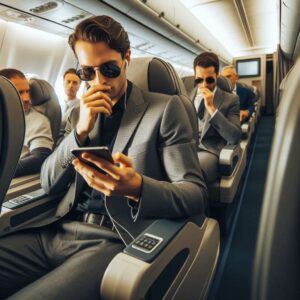
Should I Turn Off My Phone on a Plane?
Yes, you should either turn off your phone or switch it to airplane mode when flying. Airplane mode disables all wireless signals – cellular, Wi-Fi, and Bluetooth – while still allowing you to use offline features. The main reason for this requirement is to prevent potential interference with the aircraft’s communication and navigation systems.
Although the claim that mobile phones can seriously disrupt avionics is often debated, the original concerns weren’t entirely baseless. In the early days of aviation technology, cell phone signals – especially older 2G and 3G networks – could theoretically interfere with sensitive cockpit instruments or affect communication between the flight crew and air traffic control. Another concern was that phones at cruising altitude could simultaneously connect to multiple cell towers on the ground, overloading cellular networks.
Today, modern aircraft are far more resistant to such interference. Aviation systems are better shielded, and regulators have updated their guidelines accordingly. Still, many airlines continue to enforce the airplane mode rule, adopting a “better safe than sorry” stance. Besides safety, other factors – like security protocols and maintaining a calm, comfortable cabin environment- also influence these policies. After all, no one wants to be stuck next to a loud phone conversation or a chatter box at 35,000 feet.
Interestingly, many modern aircraft are now equipped with onboard technology called a picocell—basically a mini cell tower inside the plane. A picocell safely manages mobile signals within the cabin and connects them to ground networks via satellite or air-to-ground relay systems. This setup allows passengers to make calls, send texts, or use mobile data without interfering with the plane’s systems.
So why are cell phone calls still largely banned on flights, especially in the U.S., even if the technology exists? The answer lies in both regulation and passenger experience. While some international airlines allow limited use of mobile phones through onboard picocells, many avoid enabling voice calls for social reasons – cabin crews and passengers generally prefer a quieter environment.
Meanwhile, in-flight Wi-Fi has become more common. These systems do not rely on cellular networks but instead use dedicated satellite links or ground-based systems to provide internet access. Passengers can enable Wi-Fi while keeping their phones in airplane mode, avoiding mobile network disruptions altogether.
While the technical risks of using cell phones on planes have greatly diminished, the requirement to switch to airplane mode remains standard for safety, security, and comfort. And until the skies become more accommodating to in-flight voice calls, airplane mode is here to stay.
View a YouTube video on “What happens if you don’t put your phone in airplane mode when flying?”